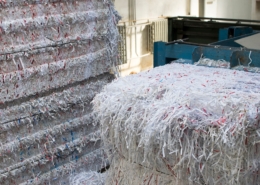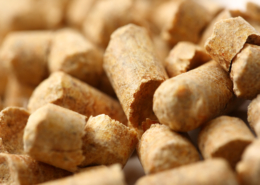La Brévine: district heating in the coldest village in Switzerland
Known for its record-breaking cold temperatures, La Brévine is now in the news for its local district heating network. Most of the houses are connected to a heating network and are heated with wood from the region.
In La Brévine, the cold is truly celebrated. In this municipality, proud of its nickname of "Swiss Siberia", colorful signs guide the visitor from the village center to the historical place - the weather station that indicates the coldest temperature ever recorded in Switzerland: - 41.8 °C! So it's not surprising that heating is also an important topic here. And yet, the way homes and domestic water are heated is astonishing: about 85% of the buildings are connected to a heat network. In May 2017, the district heating plant, with its wood chip heating plant and 2.6 kilometers of very well insulated pipes, was officially opened.
Goodbye, oil tanks!
At Monique and Marcel Brandt's house, near the center of the village, we also talk about cold and heating. Their two-storey house built in 1896 has already undergone several transformations.
In their cellar, they have installed a heating substation for connection to the electricity network District heating. Carefully stored garden tools are kept in one of the many other rooms in the cellar, which previously housed three oil tanks. The municipal administrator finds the system both reliable and comfortable: the room temperature is always sufficient, and there is no need to order fuel oil or have it swept.
A long-term and sustainable investment
On the table in the large dining room, Monique Brandt spreads out documents about the new heat source. The annual invoice shows how the bill for district heating is calculated. On the one hand, there is the basic amount, which is payable even if the house is not heated or is only slightly heated. The Brandts, who live permanently in La Brévine, pay far more than this minimum amount. They pay 16.8 centimes per kilowatt-hour consumed. Their annual expense is thus slightly higher than what they used to pay for filling their oil tanks. But it's more complicated than that," says Brandt. A new oil heater would have cost about 30,000 francs for their house: an investment that would have had to be amortized over about 20 years.
However, district heating also requires an initial investment. In the case of the Brandt family, the connection to the network cost 8,640 francs and the installation 12,500 francs. This investment does not pay for itself over two decades, like oil heating, but over a longer period.
Creation of the wood-fired district heating cooperative
As an entrepreneur, Frédéric is one of the people behind the district heating project and president of the cooperative that built the heating network, the Société coopérative de chauffage à distance au bois de La Brévine. In 2009, the municipality was looking for a solution to replace the old oil-fired heating in several public buildings. At the same time, the village's cheese factory was also planning to modernize. After a survey revealed that many private individuals were also considering renovating their heating systems, it was clear that La Brévine had the potential for a heat network. A huge boiler burns 4,000 cubic meters of wood chips per year. A visit to the "Siberia of Switzerland" shows how the heat then reaches the households.
Oil was no longer an option
According to Frédéric Cabré, if the vast majority of houses are now connected to the network, it is both out of idealism and common sense. In addition, the municipality and its 623 inhabitants are aware of current ecological issues and therefore knew that they would soon have to replace their old heating systems. But oil was no longer an option. On the one hand, because the village is built right above a water table, and it is therefore necessary to prevent any oil tank accident to protect the drinking water. On the other hand, since the energy law came into force, old oil heaters cannot be replaced by new ones in the canton of Neuchâtel.
Local wood
When you see the huge tree trunks - mainly fir trees - piled up in front of the thermal power plant, you can immediately guess the fuel used. There is enough for several months of heating. This poor quality wood is processed into chips on site. The cooperative has undertaken to collect it from within a radius of no more than 15 kilometers. The 300,000 liters of fuel oil brought to the village year after year did not contribute to the local economy. On the other hand, district heating has created 1.8 jobs here.
By offering a discount to people who decided from the start to connect to the network, but also to those who committed themselves by contract to change their heating in five or ten years. This staggered approach undoubtedly meets the needs of property owners. Every customer is part of it and has a voice - both the private individuals and the cheese factory and the municipality, which are by far the two biggest heat consumers. The municipality advanced the construction costs for the power plant building and entered into a hire-purchase agreement with the cooperative until 2049. The municipality did not want to operate the district heating plant itself, as the construction costs of 5.9 million francs would have required too much debt. The ASCAD predicts that Switzerland should be able to reach 40% by 2050. Most large cities, but also some smaller ones, are currently building district heating networks - not to mention villages like La Brévine.
 Energiejournal
Energiejournal
 ShutterstockDiminuer sa consommation d’électricité grâce aux capteurs
ShutterstockDiminuer sa consommation d’électricité grâce aux capteurs  shutterstockDank ProKilowatt: Lüftungsanlage sanieren und Strom sparen
shutterstockDank ProKilowatt: Lüftungsanlage sanieren und Strom sparen  ShutterstockL’attrait pour le chauffage aux pellets entraîne des effets secondaires
ShutterstockL’attrait pour le chauffage aux pellets entraîne des effets secondaires  ShutterstockInterview: «Dämmen statt Malen» lohnt sich!
ShutterstockInterview: «Dämmen statt Malen» lohnt sich! 
 BFE - Brigitte Mader
BFE - Brigitte Mader
Dein Kommentar
An Diskussion beteiligen?Hinterlassen Sie uns Ihren Kommentar!